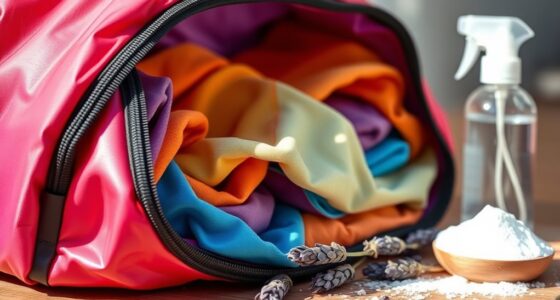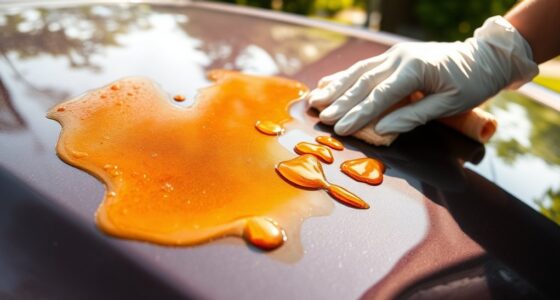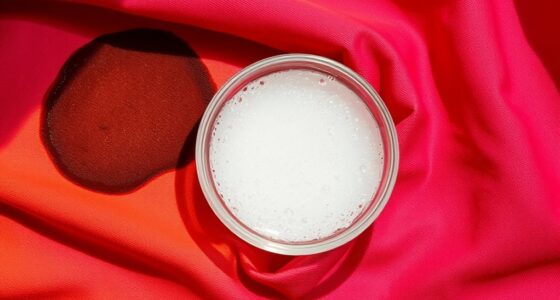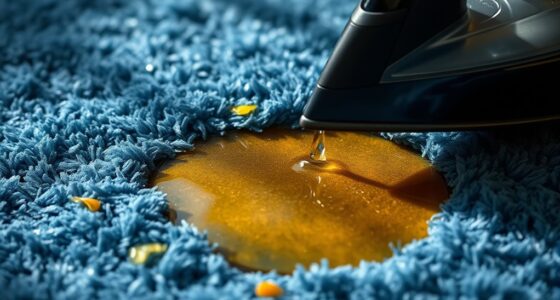To remove chewing gum from clothes and carpets, start by hardening the gum with ice, then carefully scrape it off with a blunt knife. For stubborn residue, try using rubbing alcohol or vinegar mixed with water. Avoid aggressive scraping or heat that might damage the fabric. After getting rid of the gum, maintain your items by cleaning spills promptly and using stain repellents. There’s more to discover about effective techniques and preventive measures for future stains.
Key Takeaways
- Freeze the gum using ice cubes for 15-20 minutes to harden it before scraping off gently with a dull knife or spoon.
- Use rubbing alcohol or vinegar mixed with water to help dissolve any remaining gum residue on fabrics.
- Avoid aggressive scraping to prevent damage to fabrics or carpets; always blot gently instead.
- Test any cleaning solution on a small, inconspicuous area first to ensure it won’t harm the material.
- Regularly clean and maintain surfaces to prevent future gum stains and to preserve fabric quality.
Understanding the Problem: Why Gum Sticks

When you chew gum, its sticky nature can become a nuisance if it ends up on your clothes or carpet. The main components—elastomers, resins, fillers, and plasticizers—create a strong bond through various adhesion mechanisms. Intermolecular forces like Van der Waals and hydrogen bonds increase its grip, while mechanical interlocking occurs as gum fits into tiny crevices on surfaces. Its hydrophobic nature repels water, making it resistant to washing, which means gum doesn’t dissolve in water or rain. This non-biodegradable quality contributes to environmental pollution and makes removal costly. With gum’s elasticity and tendency to stretch rather than break, you’ll find it sticks tenaciously, creating a real challenge when trying to clean it up. The original chewing gum was made from natural polymers such as chicle and tree saps, but modern formulations primarily use synthetic materials.
Tools You Need for Effective Gum Removal
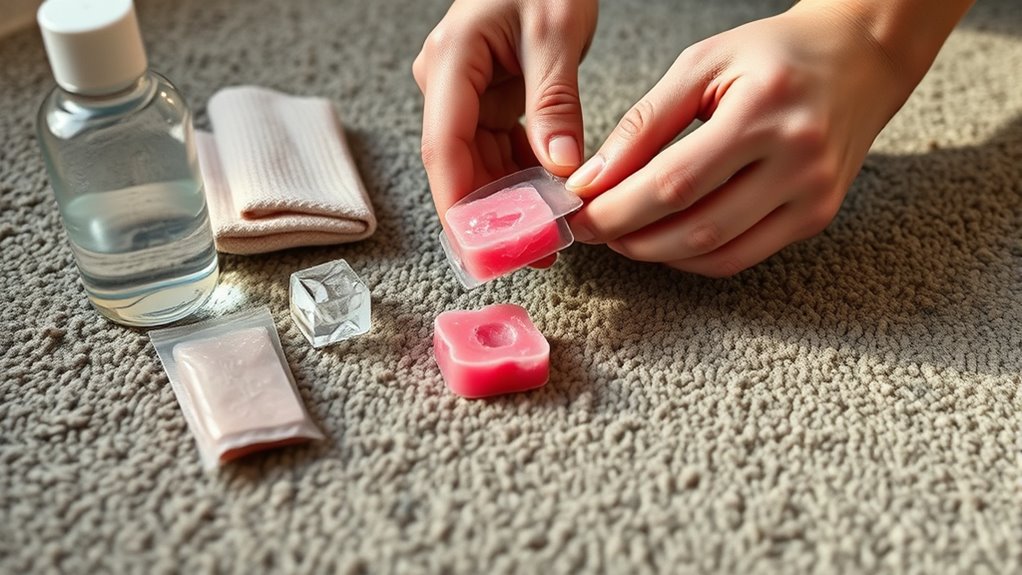
Successfully tackling gum removal starts with having the right tools on hand.
For clothes, grab a blunt knife or spatula to scrape off hardened gum without damaging the fabric. An old toothbrush is perfect for applying cleaning solutions and scrubbing away residues. You’ll also need a soft cloth or sponge to wipe away any leftover particles. Additionally, steam vapour removal can be a highly effective method when dealing with gum on fabrics, as it provides quick and efficient results.
If you’re dealing with carpets, ice cubes or a freezer pack can harden the gum, making it easier to scrape off with a dull knife or spoon. A vacuum cleaner helps remove any remaining bits, while a soft-bristled brush sweeps away residue.
Finally, having rubbing alcohol or mild dish soap handy can aid in the cleaning process.
Methods for Removing Gum From Clothes

Removing gum from clothes can be a straightforward process if you choose the right method. One effective approach is using vinegar. Heat it in the microwave, then rub it into the gum to loosen the stain.
Alternatively, try toothpaste as a gentle abrasive; just spot test it first. Rubbing alcohol also works well to dissolve gum residue. For old gum, petroleum jelly can soften it, making it easier to scrape off. Removing gum can also be accomplished without using any chemical solutions, focusing instead on an easy and effective method.
If you prefer heat, use an iron on medium heat, placing the garment gum-side down on cardboard. Hair dryers and steamers are great too, as they soften the gum for easier removal.
Always test any method on a hidden area first to avoid damaging your fabric.
Steps for Freezing and Scraping Gum
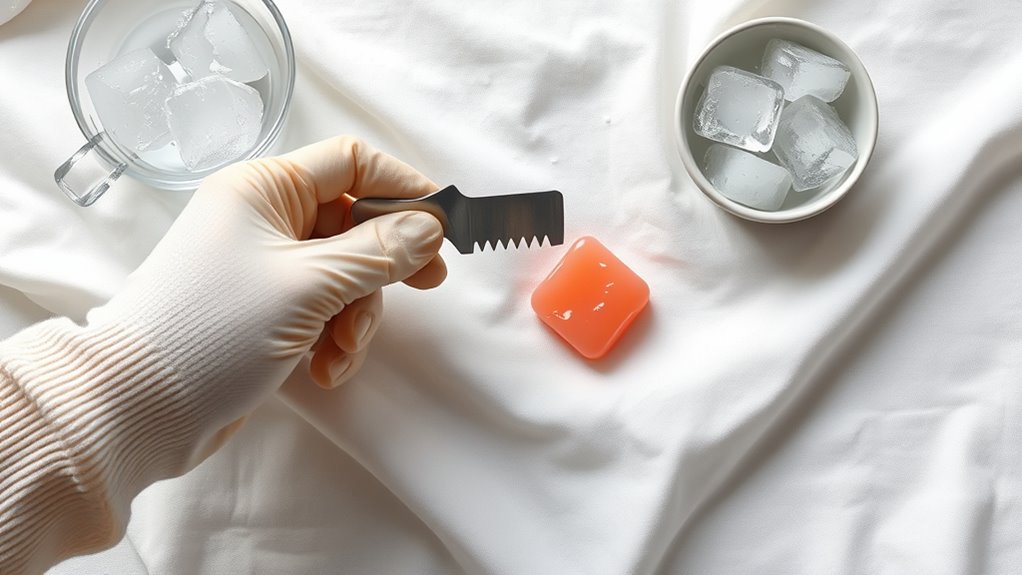
To effectively freeze and scrape gum from clothes or carpets, start by gathering your materials: plastic bags, ice cubes or a freezer, and a dull knife or spoon.
First, place the affected fabric or carpet section in a plastic bag and seal it to keep air out. If you don’t have a freezer, apply ice cubes directly to the gum for 15-20 minutes. This freezing method is essential for hardening the gum for easier removal.
Once the gum is hardened, gently scrape it off with a dull knife or spoon, using a butter knife or credit card for delicate fabrics.
After scraping, rinse the area with cold water, then launder or air dry your garment as needed.
This method helps you effectively remove stubborn gum without damaging your items.
Using Heat to Loosen Gum From Fabrics

After you’ve tried freezing and scraping the gum off your clothes or carpets, using heat can be another effective method to loosen it.
You can use a hair dryer by holding it about six inches away from the gum; just make certain to avoid scorching the fabric. Wearing gloves protects your hands from hot gum, which can become extremely hot. Always pretest on a hidden area to confirm your fabric can handle the heat. Using indirect heat can effectively soften the gum, making it easier to remove without damaging the fabric.
If you’re using an iron, place the garment gum-side down on cardboard and apply medium heat. Steaming is also a good option for loosening gum.
Apply heat until the gum softens, then carefully peel it away, avoiding any direct heat that could damage your fabric.
Chemical Solutions for Gum Removal

Chemical solutions offer a range of effective options for tackling chewing gum on clothes and carpets. Enzyme-based cleaners break down gum without damaging surfaces, while vinegar mixed with water can help dissolve it on various materials. Rubbing alcohol is great for removing gum residue from fabrics, and commercial products like SSS Chewing Gum Remover freeze gum for easy removal. You might also consider laundry detergent mixtures for pre-treating gum stains. While WD-40 can remove gum, be cautious of oily residue. Opt for eco-friendly solutions like vinegar or alcohol to minimize environmental impact. Always test any chemical on a small area first to avoid damage or discoloration. Stay safe by using protective gear when handling these substances. Additionally, using a chewing gum removal machine can quickly dissolve gum in just 6 seconds, providing a highly efficient cleaning solution.
Removing Gum From Carpets: a Step-By-Step Guide

Removing gum from carpets can be tackled effectively with a straightforward approach. Start by acting quickly, as fresh gum is easier to remove. Test your cleaning method on an inconspicuous area to avoid damage. Gather materials like ice, a scraping tool, and a carpet-safe cleaner.
For the freezing method, place ice in a bag on the gum for 10-15 minutes, then gently scrape away the hardened gum. If using heat, apply a hair dryer for 1-2 minutes, then pick up the softened gum with a rag. For stubborn residue, use a brush or WD-40 approach.
Always scrape in one direction and wear gloves for protection. Repeat as needed until the gum is fully removed.
Preventing Gum Stains Before They Happen
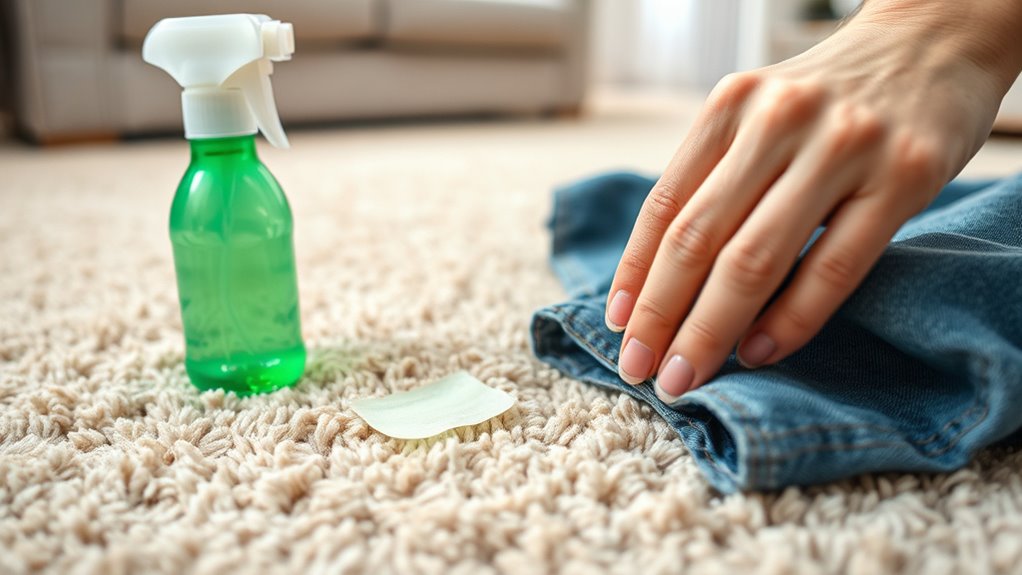
Taking steps to prevent gum stains can save you from the hassle of removal later on.
Start by educating yourself and others about the risks of chewing gum near carpets and clothing. Encourage proper disposal of used gum to keep surfaces clean.
Consider using fabric protectors on your clothes and carpets to make future cleanups easier. If you want to minimize gum exposure, try alternatives like sugar-free mints. Additionally, keep in mind that freezing gum is a simple method for removing gum stains effectively if they occur.
Regular cleaning of surfaces can also help prevent gum buildup. In your home, establish gum-free zones and supervise children while they chew gum.
Finally, using gum-resistant mats can further protect your carpets and fabrics from accidental stains. Being proactive now can save you a lot of trouble later!
Common Mistakes to Avoid During Gum Removal

When tackling gum removal, avoiding common pitfalls can make a significant difference in the outcome.
One mistake is aggressive scraping; using sharp tools can damage your fabric or carpet. Also, be cautious with heat—excessive heat can shrink or discolor materials. Always test cleaning solutions on a small area first; inadequate testing can lead to unwanted damage. This is especially important because gum hardening over time can make it more difficult to remove if not addressed promptly.
Avoid aggressive scraping and excessive heat when removing gum, as they can damage fabrics and lead to discoloration. Always test solutions first.
Instead of rubbing, gently blot the gum to prevent spreading. For carpets, avoid harsh chemicals that may ruin fibers, and don’t over-wet the area to prevent mold.
When using ice, don’t leave it too long, and avoid direct contact with the surface.
Finally, guarantee proper ventilation when using solvents and rinse thoroughly to remove any residue.
Tips for Maintaining Your Clothes and Carpets After Removal

After successfully removing chewing gum from your clothes and carpets, it’s important to focus on maintaining their condition to prevent future stains and damage.
Establish a regular cleaning schedule to keep surfaces fresh and avoid stains from setting in. Consider applying fabric or carpet stain repellents for added protection. When spills occur, clean them promptly to minimize lasting damage.
Choose stain-resistant materials for your clothes and carpets, and store them neatly to reduce accidental stains. Use gentle detergents and wash in cold water to preserve fabric quality.
Vacuum carpets regularly and schedule professional cleanings to refresh them. Finally, place rugs in high-traffic areas to protect your carpets and use deodorizers to keep them smelling fresh.
Frequently Asked Questions
Can I Use Vinegar on All Fabric Types?
You can’t use vinegar on all fabric types.
While it’s great for cotton and linen, it mightn’t be suitable for delicate or colored fabrics. The acidity can cause color fading or damage synthetic fibers.
Always check the fabric care label and test a small area first. If you’re unsure, consider safer alternatives like dish soap or oil-based solvents, especially for sensitive materials.
Protecting your fabrics is key to maintaining their appearance!
How Can I Remove Gum From Shoes?
To remove gum from your shoes, start by evaluating the type of shoe and gum involved.
Gather materials like an ice pack or hair dryer.
For freezing, apply the ice pack to harden the gum, then scrape it off with a blunt tool.
If it’s softening you prefer, use a hair dryer to warm the gum before scraping.
Finally, clean any residue with adhesive remover or peanut butter, then rinse and dry the area.
What if the Gum Is Already Set In?
If the gum’s already set in, don’t worry; you can still tackle it effectively.
Start by freezing the gum to harden it, making it easier to scrape off. You can also try using solvents like acetone or specialized adhesive removers to dissolve it.
Just be cautious with the fabric and always test a small area first.
Is There a Natural Alternative for Gum Removal?
When life hands you gum, don’t fret! You’ve got natural alternatives at your fingertips.
Peanut butter and olive oil can work wonders, loosening that sticky mess with ease. Coconut oil’s heat can dissolve gum, while mayonnaise offers a similar solution.
For a quirky twist, try rubbing with a banana peel! Each option’s a little miracle, helping you reclaim your surfaces without harsh chemicals.
How Do I Prevent Gum From Sticking to My Clothes?
To prevent gum from sticking to your clothes, dress wisely in materials like cotton or polyester that resist adhesion.
Establish gum-free zones to minimize risk, and always watch where you sit.
Use trays or placemats when chewing gum to catch any stray pieces.
Regularly check your clothing for any gum before it gets stuck, and encourage proper disposal habits to keep your environment clean and gum-free.
Conclusion
Now that you’re armed with effective gum removal techniques, envision your clothes and carpets free from sticky remnants, restored to their original glory. By understanding the science behind gum adhesion and using the right tools—whether it’s the chill of a freezer or the warmth of an iron—you’ll conquer this pesky problem. With a little care and preventive measures, you can keep your fabrics looking pristine, turning potential disasters into mere memories of the past.


